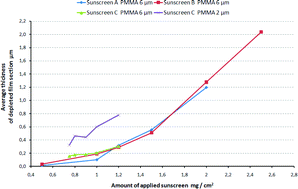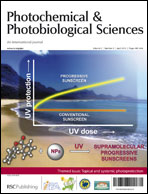Spectroscopic in vitro assay has recently gained importance for UVA protection, or even for SPF assessment, as manufacturers are increasingly keen to replace in vivo by in vitro tests. These assays are based on transmission UV spectroscopy of a known amount of sunscreen product spread onto an ultraviolet-transparent substrate. In the most recent European publications or methods, the preferred substrate is a roughened PMMA plate. We demonstrated in a previous work the importance of a strict control of plate roughness to ensure reproducibility and repeatability of in vitro results. In the present paper, we studied the effect of varying the thickness of applied sunscreen on low or high plate roughness. Two optimal sunscreen amounts, 0.75 mg cm−2 for low roughness and 1.2 mg cm−2 for high roughness, could achieve in vitro SPF close to in vivo SPF. The UV absorption spectra were measured and analyzed, via a mathematical model of irregular film geometry based on a well-known statistical distribution, the gamma law function. Our calculations show the relevance of the model to describe correctly the sunscreen film geometry evolution according to different in vitro spectra changes. Inversely, adjustment of the film geometry to fit with a set of in vivo SPF results allows us to extrapolate the real UV absorption spectra of sunscreens applied on the skin at 2 mg cm−2. A high plate roughness, preferably a moulded plate for reproducibility, is required to obtain the closest agreement between in vitro and in vivo sunscreen absorption spectra over the entire UV waveband.

You have access to this article
 Please wait while we load your content...
Something went wrong. Try again?
Please wait while we load your content...
Something went wrong. Try again?


 Please wait while we load your content...
Please wait while we load your content...